1 Mybatis入门
1.1 单独使用jdbc编程问题总结
1.1.1 jdbc程序
public static void main(String[] args) { Connection connection = null; PreparedStatement preparedStatement = null; ResultSet resultSet = null; try { //加载数据库驱动 Class.forName("com.mysql.jdbc.Driver"); //通过驱动管理类获取数据库链接 connection = DriverManager.getConnection("jdbc:mysql://localhost:3306/mybatis?characterEncoding=utf-8", "root", "mysql"); //定义sql语句 ?表示占位符 String sql = "select * from user where username = ?"; //获取预处理statement preparedStatement = connection.prepareStatement(sql); //设置参数,第一个参数为sql语句中参数的序号(从1开始),第二个参数为设置的参数值 preparedStatement.setString(1, "王五"); //向数据库发出sql执行查询,查询出结果集 resultSet = preparedStatement.executeQuery(); //遍历查询结果集 while(resultSet.next()){ System.out.println(resultSet.getString("id")+" "+resultSet.getString("username")); } } catch (Exception e) { e.printStackTrace(); }finally{ //释放资源 if(resultSet!=null){ try { resultSet.close(); } catch (SQLException e) { // TODO Auto-generated catch block e.printStackTrace(); } } if(preparedStatement!=null){ try { preparedStatement.close(); } catch (SQLException e) { // TODO Auto-generated catch block e.printStackTrace(); } } if(connection!=null){ try { connection.close(); } catch (SQLException e) { // TODO Auto-generated catch block e.printStackTrace(); } } } }
上边使用jdbc的原始方法(未经封装)实现了查询数据库表记录的操作。
1.1.2 jdbc编程步骤:
- 加载数据库驱动
- 创建并获取数据库链接
- 创建jdbc statement对象
- 设置sql语句
- 设置sql语句中的参数(使用preparedStatement)
- 通过statement执行sql并获取结果
- 对sql执行结果进行解析处理
- 释放资源(resultSet、preparedstatement、connection)
1.1.3 jdbc问题总结如下:
- 数据库链接创建、释放频繁造成系统资源浪费从而影响系统性能,如果使用数据库链接池可解决此问题。
- Sql语句在代码中硬编码,造成代码不易维护,实际应用sql变化的可能较大,sql变动需要改变java代码。
- 使用preparedStatement向占有位符号传参数存在硬编码,因为sql语句的where条件不一定,可能多也可能少,修改sql还要修改代码,系统不易维护。
- 对结果集解析存在硬编码(查询列名),sql变化导致解析代码变化,系统不易维护,如果能将数据库记录封装成pojo对象解析比较方便。
1.2 MyBatis介绍
MyBatis 本是apache的一个开源项目iBatis, 2010年这个项目由apache software foundation 迁移到了google code,并且改名为MyBatis,实质上Mybatis对ibatis进行一些改进。
MyBatis是一个优秀的持久层框架,它对jdbc的操作数据库的过程进行封装,使开发者只需要关注 SQL 本身,而不需要花费精力去处理例如注册驱动、创建connection、创建statement、手动设置参数、结果集检索等jdbc繁杂的过程代码。
Mybatis通过xml或注解的方式将要执行的各种statement(statement、preparedStatemnt、CallableStatement)配置起来,并通过java对象和statement中的sql进行映射生成最终执行的sql语句,最后由mybatis框架执行sql并将结果映射成java对象并返回。
1.3 Mybatis架构
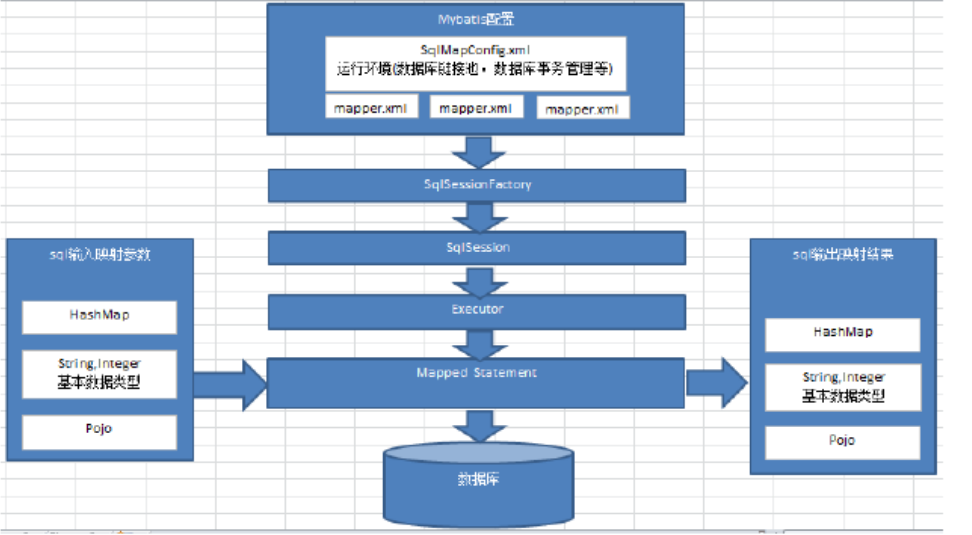
- mybatis配置
SqlMapConfig.xml,此文件作为mybatis的全局配置文件,配置了mybatis的运行环境等信息。
mapper.xml文件即sql映射文件,文件中配置了操作数据库的sql语句。此文件需要在SqlMapConfig.xml中加载。
- 通过mybatis环境等配置信息构造SqlSessionFactory即会话工厂
- 由会话工厂创建sqlSession即会话,操作数据库需要通过sqlSession进行。
- mybatis底层自定义了Executor执行器接口操作数据库,Executor接口有两个实现,一个是基本执行器、一个是缓存执行器。
- Mapped Statement也是mybatis一个底层封装对象,它包装了mybatis配置信息及sql映射信息等。mapper.xml文件中一个sql对应一个Mapped Statement对象,sql的id即是Mapped statement的id。
- Mapped Statement对sql执行输入参数进行定义,包括HashMap、基本类型、pojo,Executor通过Mapped Statement在执行sql前将输入的java对象映射至sql中,输入参数映射就是jdbc编程中对preparedStatement设置参数。
- Mapped Statement对sql执行输出结果进行定义,包括HashMap、基本类型、pojo,Executor通过Mapped Statement在执行sql后将输出结果映射至java对象中,输出结果映射过程相当于jdbc编程中对结果的解析处理过程。
1.4 mybatis下载
mybaits的代码由github.com管理,地址:https://github.com/mybatis/mybatis-3/releases
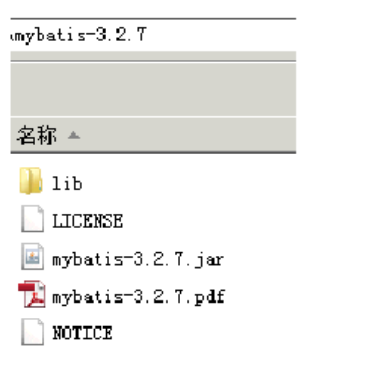
mybatis-3.2.7.jar----mybatis的核心包
lib----mybatis的依赖包
mybatis-3.2.7.pdf----mybatis使用手册
1.5 创建mysql数据库
先导入sql_table.sql,再导入 sql_data.sql脚本:
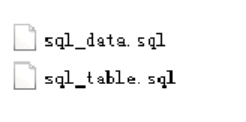
如下:

1.6 Mybatis入门程序
1.6.1 需求
实现以下功能:
根据用户id查询一个用户信息
根据用户名称模糊查询用户信息列表
添加用户
更新用户
删除用户
1.6.2 第一步:创建java工程
使用eclipse创建java工程,jdk使用1.7.0_72。
1.6.3 第二步:加入jar包
加入mybatis核心包、依赖包、数据驱动包。
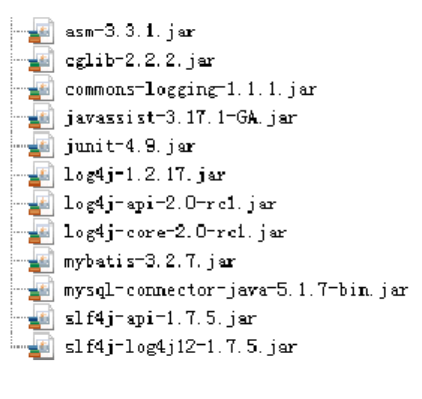
1.6.4 第三步:log4j.properties
在classpath下创建log4j.properties如下:
# Global logging configuration
log4j.rootLogger=DEBUG, stdout
# Console output...
log4j.appender.stdout=org.apache.log4j.ConsoleAppender
log4j.appender.stdout.layout=org.apache.log4j.PatternLayout
log4j.appender.stdout.layout.ConversionPattern=%5p [%t] - %m%n
mybatis默认使用log4j作为输出日志信息。
1.6.5 第四步:SqlMapConfig.xml
在classpath下创建SqlMapConfig.xml,如下:
<?xml version="1.0" encoding="UTF-8" ?> <!DOCTYPE configuration PUBLIC "-//mybatis.org//DTD Config 3.0//EN" "http://mybatis.org/dtd/mybatis-3-config.dtd"> <configuration> <!-- 和spring整合后 environments配置将废除--> <environments default="development"> <environment id="development"> <!-- 使用jdbc事务管理--> <transactionManager type="JDBC" /> <!-- 数据库连接池--> <dataSource type="POOLED"> <property name="driver" value="com.mysql.jdbc.Driver" /> <property name="url"value="jdbc:mysql://localhost:3306/mybatis?characterEncoding=utf-8"/> <property name="username" value="root" /> <property name="password" value="mysql" /> </dataSource> </environment> </environments> </configuration>
SqlMapConfig.xml是mybatis核心配置文件,上边文件的配置内容为数据源、事务管理。
1.6.6 第五步:po类
Po类作为mybatis进行sql映射使用,po类通常与数据库表对应,User.java如下:
public class User { private int id; private String username;// 用户姓名 private String sex;// 性别 private Date birthday;// 生日 private String address;// 地址 get/set……
1.6.7 第六步:程序编写
1.6.7.1 查询
1.6.7.1.1 映射文件:
在classpath下的sqlmap目录下创建sql映射文件Users.xml:
<?xml version="1.0" encoding="UTF-8" ?> <!DOCTYPE mapper PUBLIC "-//mybatis.org//DTD Mapper 3.0//EN" "http://mybatis.org/dtd/mybatis-3-mapper.dtd"> <mapper namespace="test"> </mapper>
namespace :命名空间,用于隔离sql语句,后面会讲另一层非常重要的作用。
在SqlMapConfig.xml中添加:
<!-- 根据id获取用户信息 --> <select id="findUserById" parameterType="int"resultType="cn.itcast.mybatis.po.User"> select * from user where id = #{id} </select> <!-- 自定义条件查询用户列表 --> <select id="findUserByUsername" parameterType="java.lang.String" resultType="cn.itcast.mybatis.po.User"> select * from user where username like '%${value}%' </select>
parameterType:定义输入到sql中的映射类型,#{id}表示使用preparedstatement设置占位符号并将输入变量id传到sql。
resultType:定义结果映射类型。
1.6.7.1.2 加载映射文件
mybatis框架需要加载映射文件,将Users.xml添加在SqlMapConfig.xml,如下:
<mappers> <mapper resource="sqlmap/User.xml"/> </mappers>
1.6.7.1.3 测试程序:
public class Mybatis_first { //会话工厂 private SqlSessionFactory sqlSessionFactory; @Before public void createSqlSessionFactory() throws IOException { // 配置文件 String resource = "SqlMapConfig.xml"; InputStream inputStream = Resources.getResourceAsStream(resource); // 使用SqlSessionFactoryBuilder从xml配置文件中创建SqlSessionFactory sqlSessionFactory = new SqlSessionFactoryBuilder() .build(inputStream); } // 根据 id查询用户信息 @Test public void testFindUserById() { // 数据库会话实例 SqlSession sqlSession = null; try { // 创建数据库会话实例sqlSession sqlSession = sqlSessionFactory.openSession(); // 查询单个记录,根据用户id查询用户信息 User user = sqlSession.selectOne("test.findUserById", 10); // 输出用户信息 System.out.println(user); } catch (Exception e) { e.printStackTrace(); } finally { if (sqlSession != null) { sqlSession.close(); } } } // 根据用户名称模糊查询用户信息 @Test public void testFindUserByUsername() { // 数据库会话实例 SqlSession sqlSession = null; try { // 创建数据库会话实例sqlSession sqlSession = sqlSessionFactory.openSession(); // 查询单个记录,根据用户id查询用户信息 List<User> list = sqlSession.selectList("test.findUserByUsername", "张"); System.out.println(list.size()); } catch (Exception e) { e.printStackTrace(); } finally { if (sqlSession != null) { sqlSession.close(); } } } }
1.6.7.1.4 #{}和${}
#{}表示一个占位符号,通过#{}可以实现preparedStatement向占位符中设置值,自动进行java类型和jdbc类型转换,#{}可以有效防止sql注入。 #{}可以接收简单类型值或pojo属性值。 如果parameterType传输单个简单类型值,#{}括号中可以是value或其它名称。
${}表示拼接sql串,通过${}可以将parameterType 传入的内容拼接在sql中且不进行jdbc类型转换, ${}可以接收简单类型值或pojo属性值,如果parameterType传输单个简单类型值,${}括号中只能是value。
1.6.7.1.5 parameterType和resultType
parameterType:指定输入参数类型,mybatis通过ognl从输入对象中获取参数值拼接在sql中。
resultType:指定输出结果类型,mybatis将sql查询结果的一行记录数据映射为resultType指定类型的对象。
1.6.7.1.6 selectOne和selectList
selectOne查询一条记录,如果使用selectOne查询多条记录则抛出异常:
org.apache.ibatis.exceptions.TooManyResultsException: Expected one result (or null) to be returned by selectOne(), but found: 3
at org.apache.ibatis.session.defaults.DefaultSqlSession.selectOne(DefaultSqlSession.java:70)
selectList可以查询一条或多条记录。
1.6.7.2 添加
1.6.7.2.1 映射文件:
在SqlMapConfig.xml中添加:
<!-- 添加用户 --> <insert id="insertUser"parameterType="cn.itcast.mybatis.po.User"> <selectKey keyProperty="id" order="AFTER"resultType="java.lang.Integer"> select LAST_INSERT_ID() </selectKey> insert into user(username,birthday,sex,address) values(#{username},#{birthday},#{sex},#{address}) </insert>
1.6.7.2.2 测试程序:
// 添加用户信息 @Test public void testInsert() { // 数据库会话实例 SqlSession sqlSession = null; try { // 创建数据库会话实例sqlSession sqlSession = sqlSessionFactory.openSession(); // 添加用户信息 User user = new User(); user.setUsername("张小明"); user.setAddress("河南郑州"); user.setSex("1"); user.setPrice(1999.9f); sqlSession.insert("test.insertUser", user); //提交事务 sqlSession.commit(); } catch (Exception e) { e.printStackTrace(); } finally { if (sqlSession != null) { sqlSession.close(); } } }
1.6.7.2.3 mysql自增主键返回
通过修改sql映射文件,可以将mysql自增主键返回:
<insert id="insertUser" parameterType="cn.itcast.mybatis.po.User"> <!-- selectKey将主键返回,需要再返回 --> <selectKey keyProperty="id" order="AFTER"resultType="java.lang.Integer"> select LAST_INSERT_ID() </selectKey> insert into user(username,birthday,sex,address) values(#{username},#{birthday},#{sex},#{address}); </insert>
添加selectKey实现将主键返回
keyProperty:返回的主键存储在pojo中的哪个属性
order:selectKey的执行顺序,是相对与insert语句来说,由于mysql的自增原理执行完insert语句之后才将主键生成,所以这里selectKey的执行顺序为after
resultType:返回的主键是什么类型
LAST_INSERT_ID():是mysql的函数,返回auto_increment自增列新记录id值。
1.6.7.2.4 Mysql使用 uuid实现主键
需要增加通过select uuid()得到uuid值
<insert id="insertUser" parameterType="cn.itcast.mybatis.po.User">
<selectKey resultType="java.lang.String" order="BEFORE"
keyProperty="id">
select uuid()
</selectKey>
insert into user(id,username,birthday,sex,address)
values(#{id},#{username},#{birthday},#{sex},#{address})
</insert>
注意这里使用的order是“BEFORE”
1.6.7.2.5 Oracle使用序列生成主键
首先自定义一个序列且用于生成主键,selectKey使用如下:
<insert id="insertUser" parameterType="cn.itcast.mybatis.po.User">
<selectKey resultType="java.lang.Integer" order="BEFORE"
keyProperty="id">
SELECT 自定义序列.NEXTVAL FROM DUAL
</selectKey>
insert into user(id,username,birthday,sex,address)
values(#{id},#{username},#{birthday},#{sex},#{address})
</insert>
注意这里使用的order是“BEFORE”
1.6.7.3 删除
1.6.7.3.1 映射文件:
<!-- 删除用户 --> <delete id="deleteUserById" parameterType="int"> delete from user where id=#{id} </delete>
1.6.7.3.2 测试程序:
// 根据id删除用户 @Test public void testDelete() { // 数据库会话实例 SqlSession sqlSession = null; try { // 创建数据库会话实例sqlSession sqlSession = sqlSessionFactory.openSession(); // 删除用户 sqlSession.delete("test.deleteUserById",18); // 提交事务 sqlSession.commit(); } catch (Exception e) { e.printStackTrace(); } finally { if (sqlSession != null) { sqlSession.close(); } } }
1.6.7.4 修改
1.6.7.4.1 映射文件
<!-- 更新用户 --> <update id="updateUser"parameterType="cn.itcast.mybatis.po.User"> update user set username=#{username},birthday=#{birthday},sex=#{sex},address=#{address} where id=#{id} </update>
1.6.7.4.2 测试程序
// 更新用户信息 @Test public void testUpdate() { // 数据库会话实例 SqlSession sqlSession = null; try { // 创建数据库会话实例sqlSession sqlSession = sqlSessionFactory.openSession(); // 添加用户信息 User user = new User(); user.setId(16); user.setUsername("张小明"); user.setAddress("河南郑州"); user.setSex("1"); user.setPrice(1999.9f); sqlSession.update("test.updateUser", user); // 提交事务 sqlSession.commit(); } catch (Exception e) { e.printStackTrace(); } finally { if (sqlSession != null) { sqlSession.close(); } } }
1.6.8 Mybatis解决jdbc编程的问题
- 数据库链接创建、释放频繁造成系统资源浪费从而影响系统性能,如果使用数据库链接池可解决此问题。
解决:在SqlMapConfig.xml中配置数据链接池,使用连接池管理数据库链接。
- Sql语句写在代码中造成代码不易维护,实际应用sql变化的可能较大,sql变动需要改变java代码。
解决:将Sql语句配置在XXXXmapper.xml文件中与java代码分离。
- 向sql语句传参数麻烦,因为sql语句的where条件不一定,可能多也可能少,占位符需要和参数一一对应。
解决:Mybatis自动将java对象映射至sql语句,通过statement中的parameterType定义输入参数的类型。
- 对结果集解析麻烦,sql变化导致解析代码变化,且解析前需要遍历,如果能将数据库记录封装成pojo对象解析比较方便。
解决:Mybatis自动将sql执行结果映射至java对象,通过statement中的resultType定义输出结果的类型。
1.6.9 与hibernate不同
Mybatis和hibernate不同,它不完全是一个ORM框架,因为MyBatis需要程序员自己编写Sql语句,不过mybatis可以通过XML或注解方式灵活配置要运行的sql语句,并将java对象和sql语句映射生成最终执行的sql,最后将sql执行的结果再映射生成java对象。
Mybatis学习门槛低,简单易学,程序员直接编写原生态sql,可严格控制sql执行性能,灵活度高,非常适合对关系数据模型要求不高的软件开发,例如互联网软件、企业运营类软件等,因为这类软件需求变化频繁,一但需求变化要求成果输出迅速。但是灵活的前提是mybatis无法做到数据库无关性,如果需要实现支持多种数据库的软件则需要自定义多套sql映射文件,工作量大。
Hibernate对象/关系映射能力强,数据库无关性好,对于关系模型要求高的软件(例如需求固定的定制化软件)如果用hibernate开发可以节省很多代码,提高效率。但是Hibernate的学习门槛高,要精通门槛更高,而且怎么设计O/R映射,在性能和对象模型之间如何权衡,以及怎样用好Hibernate需要具有很强的经验和能力才行。
总之,按照用户的需求在有限的资源环境下只要能做出维护性、扩展性良好的软件架构都是好架构,所以框架只有适合才是最好。
2 Dao开发方法
使用Mybatis开发Dao,通常有两个方法,即原始Dao开发方法和Mapper接口开发方法。
2.1 需求
将下边的功能实现Dao:
根据用户id查询一个用户信息
根据用户名称模糊查询用户信息列表
添加用户信息
2.2 SqlSession的使用范围
SqlSession中封装了对数据库的操作,如:查询、插入、更新、删除等。
通过SqlSessionFactory创建SqlSession,而SqlSessionFactory是通过SqlSessionFactoryBuilder进行创建。
2.2.1 SqlSessionFactoryBuilder
SqlSessionFactoryBuilder用于创建SqlSessionFacoty,SqlSessionFacoty一旦创建完成就不需要SqlSessionFactoryBuilder了,因为SqlSession是通过SqlSessionFactory生产,所以可以将SqlSessionFactoryBuilder当成一个工具类使用,最佳使用范围是方法范围即方法体内局部变量。
2.2.2 SqlSessionFactory
SqlSessionFactory是一个接口,接口中定义了openSession的不同重载方法,SqlSessionFactory的最佳使用范围是整个应用运行期间,一旦创建后可以重复使用,通常以单例模式管理SqlSessionFactory。
2.2.3 SqlSession
SqlSession是一个面向用户的接口, sqlSession中定义了数据库操作,默认使用DefaultSqlSession实现类。
执行过程如下:
- 加载数据源等配置信息
Environment environment = configuration.getEnvironment();
- 创建数据库链接
- 创建事务对象
- 创建Executor,SqlSession所有操作都是通过Executor完成,mybatis源码如下:
if (ExecutorType.BATCH == executorType) { executor = newBatchExecutor(this, transaction); } elseif (ExecutorType.REUSE == executorType) { executor = new ReuseExecutor(this, transaction); } else { executor = new SimpleExecutor(this, transaction); } if (cacheEnabled) { executor = new CachingExecutor(executor, autoCommit); }
- SqlSession的实现类即DefaultSqlSession,此对象中对操作数据库实质上用的是Executor
结论:
每个线程都应该有它自己的SqlSession实例。SqlSession的实例不能共享使用,它也是线程不安全的。因此最佳的范围是请求或方法范围。绝对不能将SqlSession实例的引用放在一个类的静态字段或实例字段中。
打开一个 SqlSession;使用完毕就要关闭它。通常把这个关闭操作放到 finally块中以确保每次都能执行关闭。如下:
SqlSession session = sqlSessionFactory.openSession(); try { // do work } finally { session.close(); }
2.3 原始Dao开发方式
原始Dao开发方法需要程序员编写Dao接口和Dao实现类。
2.3.1 映射文件
<?xml version="1.0" encoding="UTF-8" ?> <!DOCTYPE mapper PUBLIC "-//mybatis.org//DTD Mapper 3.0//EN" "http://mybatis.org/dtd/mybatis-3-mapper.dtd"> <mapper namespace="test"> <!-- 根据id获取用户信息 --> <select id="findUserById" parameterType="int"resultType="cn.itcast.mybatis.po.User"> select * from user where id = #{id} </select> <!-- 添加用户 --> <insert id="insertUser"parameterType="cn.itcast.mybatis.po.User"> <selectKey keyProperty="id" order="AFTER"resultType="java.lang.Integer"> select LAST_INSERT_ID() </selectKey> insert into user(username,birthday,sex,address) values(#{username},#{birthday},#{sex},#{address}) </insert> </mapper>
2.3.2 Dao接口
Public interface UserDao { public User getUserById(int id) throws Exception; public void insertUser(User user) throws Exception; } Public class UserDaoImpl implements UserDao { //注入SqlSessionFactory public UserDaoImpl(SqlSessionFactory sqlSessionFactory){ this.setSqlSessionFactory(sqlSessionFactory); } private SqlSessionFactory sqlSessionFactory; @Override public User getUserById(int id) throws Exception { SqlSession session = sqlSessionFactory.openSession(); User user = null; try { //通过sqlsession调用selectOne方法获取一条结果集 //参数1:指定定义的statement的id,参数2:指定向statement中传递的参数 user = session.selectOne("test.findUserById", 1); System.out.println(user); } finally{ session.close(); } return user; } @Override Public void insertUser(User user) throws Exception { SqlSession sqlSession = sqlSessionFactory.openSession(); try { sqlSession.insert("insertUser", user); sqlSession.commit(); } finally{ session.close(); } } }
2.3.3 问题
原始Dao开发中存在以下问题:
- Dao方法体存在重复代码:通过SqlSessionFactory创建SqlSession,调用SqlSession的数据库操作方法
- 调用sqlSession的数据库操作方法需要指定statement的id,这里存在硬编码,不得于开发维护。
2.4 Mapper动态代理方式
2.4.1 实现原理
Mapper接口开发方法只需要程序员编写Mapper接口(相当于Dao接口),由Mybatis框架根据接口定义创建接口的动态代理对象,代理对象的方法体同上边Dao接口实现类方法。
Mapper接口开发需要遵循以下规范:
- Mapper.xml文件中的namespace与mapper接口的类路径相同。
- Mapper接口方法名和Mapper.xml中定义的每个statement的id相同
- Mapper接口方法的输入参数类型和mapper.xml中定义的每个sql 的parameterType的类型相同
- Mapper接口方法的输出参数类型和mapper.xml中定义的每个sql的resultType的类型相同
2.4.2 Mapper.xml(映射文件)
定义mapper映射文件UserMapper.xml(内容同Users.xml),需要修改namespace的值为 UserMapper接口路径。将UserMapper.xml放在classpath下mapper目录 下。
<?xml version="1.0" encoding="UTF-8" ?> <!DOCTYPE mapper PUBLIC "-//mybatis.org//DTD Mapper 3.0//EN" "http://mybatis.org/dtd/mybatis-3-mapper.dtd"> <mapper namespace="cn.itcast.mybatis.mapper.UserMapper"> <!-- 根据id获取用户信息 --> <select id="findUserById" parameterType="int"resultType="cn.itcast.mybatis.po.User"> select * from user where id = #{id} </select> <!-- 自定义条件查询用户列表 --> <select id="findUserByUsername" parameterType="java.lang.String" resultType="cn.itcast.mybatis.po.User"> select * from user where username like '%${value}%' </select> <!-- 添加用户 --> <insert id="insertUser"parameterType="cn.itcast.mybatis.po.User"> <selectKey keyProperty="id" order="AFTER"resultType="java.lang.Integer"> select LAST_INSERT_ID() </selectKey> insert into user(username,birthday,sex,address) values(#{username},#{birthday},#{sex},#{address}) </insert> </mapper>
2.4.3 Mapper.java(接口文件)
/** * 用户管理mapper */ Public interface UserMapper { //根据用户id查询用户信息 public User findUserById(int id) throws Exception; //查询用户列表 public List<User> findUserByUsername(String username) throwsException; //添加用户信息 public void insertUser(User user)throws Exception; }
接口定义有如下特点:
- Mapper接口方法名和Mapper.xml中定义的statement的id相同
- Mapper接口方法的输入参数类型和mapper.xml中定义的statement的parameterType的类型相同
- Mapper接口方法的输出参数类型和mapper.xml中定义的statement的resultType的类型相同
2.4.4 加载UserMapper.xml文件
修改SqlMapConfig.xml文件:
<!-- 加载映射文件 --> <mappers> <mapper resource="mapper/UserMapper.xml"/> </mappers>
2.4.5 测试
Public class UserMapperTest extends TestCase { private SqlSessionFactory sqlSessionFactory; protected void setUp() throws Exception { //mybatis配置文件 String resource = "sqlMapConfig.xml"; InputStream inputStream = Resources.getResourceAsStream(resource); //使用SqlSessionFactoryBuilder创建sessionFactory sqlSessionFactory = newSqlSessionFactoryBuilder().build(inputStream); } Public void testFindUserById() throws Exception { //获取session SqlSession session = sqlSessionFactory.openSession(); //获取mapper接口的代理对象 UserMapper userMapper = session.getMapper(UserMapper.class); //调用代理对象方法 User user = userMapper.findUserById(1); System.out.println(user); //关闭session session.close(); } @Test public void testFindUserByUsername() throws Exception { SqlSession sqlSession = sqlSessionFactory.openSession(); UserMapper userMapper = sqlSession.getMapper(UserMapper.class); List<User> list = userMapper.findUserByUsername("张"); System.out.println(list.size()); } Public void testInsertUser() throws Exception { //获取session SqlSession session = sqlSessionFactory.openSession(); //获取mapper接口的代理对象 UserMapper userMapper = session.getMapper(UserMapper.class); //要添加的数据 User user = new User(); user.setUsername("张三"); user.setBirthday(new Date()); user.setSex("1"); user.setAddress("北京市"); //通过mapper接口添加用户 userMapper.insertUser(user); //提交 session.commit(); //关闭session session.close(); } }
2.4.6 总结
- selectOne和selectList
动态代理对象调用sqlSession.selectOne()和sqlSession.selectList()是根据mapper接口方法的返回值决定,如果返回list则调用selectList方法,如果返回单个对象则调用selectOne方法。
- namespace
mybatis官方推荐使用mapper代理方法开发mapper接口,程序员不用编写mapper接口实现类,使用mapper代理方法时,输入参数可以使用pojo包装对象或map对象,保证dao的通用性。
3 SqlMapConfig.xml配置文件
3.1 配置内容
SqlMapConfig.xml中配置的内容和顺序如下:
properties(属性)
settings(全局配置参数)
typeAliases(类型别名)
typeHandlers(类型处理器)
objectFactory(对象工厂)
plugins(插件)
environments(环境集合属性对象)
environment(环境子属性对象)
transactionManager(事务管理)
dataSource(数据源)
mappers(映射器)
3.2 properties(属性)
SqlMapConfig.xml可以引用java属性文件中的配置信息如下:
在classpath下定义db.properties文件,
jdbc.driver=com.mysql.jdbc.Driver
jdbc.url=jdbc:mysql://localhost:3306/mybatis
jdbc.username=root
jdbc.password=mysql
SqlMapConfig.xml引用如下:
<properties resource="db.properties"/> <environments default="development"> <environment id="development"> <transactionManager type="JDBC"/> <dataSource type="POOLED"> <property name="driver" value="${jdbc.driver}"/> <property name="url" value="${jdbc.url}"/> <property name="username" value="${jdbc.username}"/> <property name="password" value="${jdbc.password}"/> </dataSource> </environment> </environments>
注意: MyBatis 将按照下面的顺序来加载属性:
- 在 properties 元素体内定义的属性首先被读取。
- 然后会读取properties 元素中resource或 url 加载的属性,它会覆盖已读取的同名属性。
- 最后读取parameterType传递的属性,它会覆盖已读取的同名属性。
因此,通过parameterType传递的属性具有最高优先级,resource或 url 加载的属性次之,最低优先级的是 properties 元素体内定义的属性。
3.3 settings(配置)
mybatis全局配置参数,全局参数将会影响mybatis的运行行为。
详细参见“学习资料/mybatis-settings.xlsx”文件
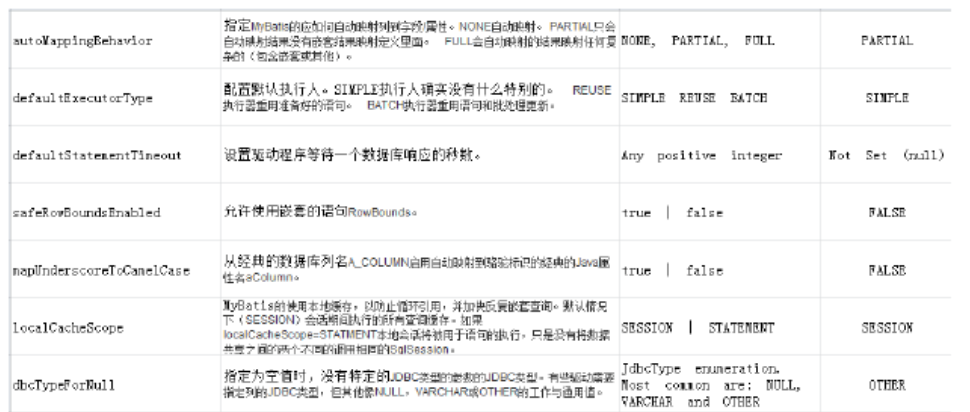
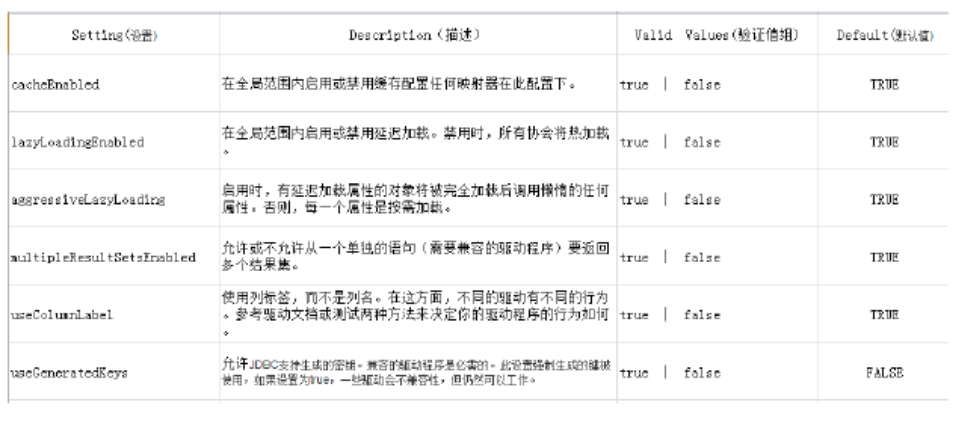
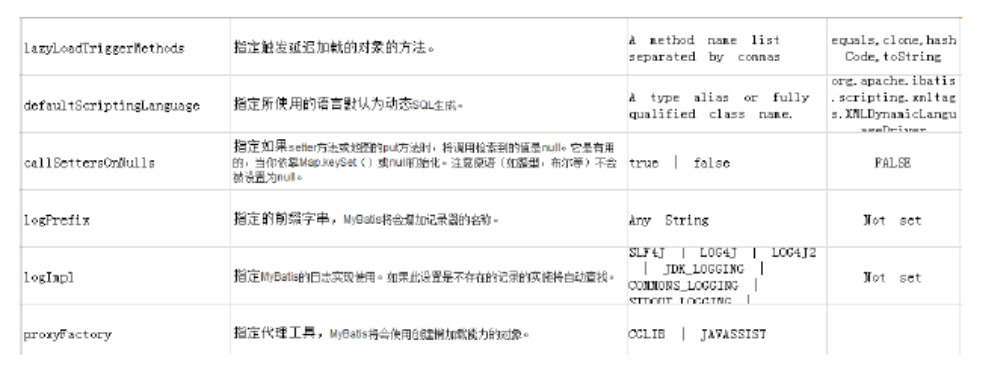
3.4 typeAliases(类型别名)
3.4.1 mybatis支持别名:
|
别名 |
映射的类型 |
|
_byte |
byte |
|
_long |
long |
|
_short |
short |
|
_int |
int |
|
_integer |
int |
|
_double |
double |
|
_float |
float |
|
_boolean |
boolean |
|
string |
String |
|
byte |
Byte |
|
long |
Long |
|
short |
Short |
|
int |
Integer |
|
integer |
Integer |
|
double |
Double |
|
float |
Float |
|
boolean |
Boolean |
|
date |
Date |
|
decimal |
BigDecimal |
|
bigdecimal |
BigDecimal |
3.4.2 自定义别名:
在SqlMapConfig.xml中配置:
<typeAliases> <!-- 单个别名定义 --> <typeAlias alias="user" type="cn.itcast.mybatis.po.User"/> <!-- 批量别名定义,扫描整个包下的类,别名为类名(首字母大写或小写都可以) --> <package name="cn.itcast.mybatis.po"/> <package name="其它包"/> </typeAliases>
3.5 typeHandlers(类型处理器)
类型处理器用于java类型和jdbc类型映射,如下:
<select id="findUserById" parameterType="int" resultType="user"> select * from user where id = #{id} </select>
mybatis自带的类型处理器基本上满足日常需求,不需要单独定义。
mybatis支持类型处理器:
|
类型处理器 |
Java类型 |
JDBC类型 |
|
BooleanTypeHandler |
Boolean,boolean |
任何兼容的布尔值 |
|
ByteTypeHandler |
Byte,byte |
任何兼容的数字或字节类型 |
|
ShortTypeHandler |
Short,short |
任何兼容的数字或短整型 |
|
IntegerTypeHandler |
Integer,int |
任何兼容的数字和整型 |
|
LongTypeHandler |
Long,long |
任何兼容的数字或长整型 |
|
FloatTypeHandler |
Float,float |
任何兼容的数字或单精度浮点型 |
|
DoubleTypeHandler |
Double,double |
任何兼容的数字或双精度浮点型 |
|
BigDecimalTypeHandler |
BigDecimal |
任何兼容的数字或十进制小数类型 |
|
StringTypeHandler |
String |
CHAR和VARCHAR类型 |
|
ClobTypeHandler |
String |
CLOB和LONGVARCHAR类型 |
|
NStringTypeHandler |
String |
NVARCHAR和NCHAR类型 |
|
NClobTypeHandler |
String |
NCLOB类型 |
|
ByteArrayTypeHandler |
byte[] |
任何兼容的字节流类型 |
|
BlobTypeHandler |
byte[] |
BLOB和LONGVARBINARY类型 |
|
DateTypeHandler |
Date(java.util) |
TIMESTAMP类型 |
|
DateOnlyTypeHandler |
Date(java.util) |
DATE类型 |
|
TimeOnlyTypeHandler |
Date(java.util) |
TIME类型 |
|
SqlTimestampTypeHandler |
Timestamp(java.sql) |
TIMESTAMP类型 |
|
SqlDateTypeHandler |
Date(java.sql) |
DATE类型 |
|
SqlTimeTypeHandler |
Time(java.sql) |
TIME类型 |
|
ObjectTypeHandler |
任意 |
其他或未指定类型 |
|
EnumTypeHandler |
Enumeration类型 |
VARCHAR-任何兼容的字符串类型,作为代码存储(而不是索引)。 |
3.6 mappers(映射器)
Mapper配置的几种方法:
3.6.1 <mapper resource=" " />
使用相对于类路径的资源
如:<mapper resource="sqlmap/User.xml" />
3.6.2 <mapper url=" " />
使用完全限定路径
如:<mapper url="file:///D:workspace_spingmvcmybatis_01configsqlmapUser.xml" />
3.6.3 <mapper class=" " />
使用mapper接口类路径
如:<mapper class="cn.itcast.mybatis.mapper.UserMapper"/>
注意:此种方法要求mapper接口名称和mapper映射文件名称相同,且放在同一个目录中。
3.6.4 <package name=""/>
注册指定包下的所有mapper接口
如:<package name="cn.itcast.mybatis.mapper"/>
注意:此种方法要求mapper接口名称和mapper映射文件名称相同,且放在同一个目录中。
4 Mapper.xml映射文件
Mapper.xml映射文件中定义了操作数据库的sql,每个sql是一个statement,映射文件是mybatis的核心。
4.1 parameterType(输入类型)
4.1.1 #{}与${}
#{}实现的是向prepareStatement中的预处理语句中设置参数值,sql语句中#{}表示一个占位符即?。
<!-- 根据id查询用户信息 --> <select id="findUserById" parameterType="int" resultType="user"> select * from user where id = #{id} </select>
使用占位符#{}可以有效防止sql注入,在使用时不需要关心参数值的类型,mybatis会自动进行java类型和jdbc类型的转换。#{}可以接收简单类型值或pojo属性值,如果parameterType传输单个简单类型值,#{}括号中可以是value或其它名称。
${}和#{}不同,通过${}可以将parameterType 传入的内容拼接在sql中且不进行jdbc类型转换, ${}可以接收简单类型值或pojo属性值,如果parameterType传输单个简单类型值,${}括号中只能是value。使用${}不能防止sql注入,但是有时用${}会非常方便,如下的例子:
<!-- 根据名称模糊查询用户信息 --> <select id="selectUserByName" parameterType="string"resultType="user"> select * from user where username like '%${value}%' </select>
如果本例子使用#{}则传入的字符串中必须有%号,而%是人为拼接在参数中,显然有点麻烦,如果采用${}在sql中拼接为%的方式则在调用mapper接口传递参数就方便很多。
//如果使用占位符号则必须人为在传参数中加%
List<User> list = userMapper.selectUserByName("%管理员%");
//如果使用${}原始符号则不用人为在参数中加%
List<User>list = userMapper.selectUserByName("管理员");
再比如order by排序,如果将列名通过参数传入sql,根据传的列名进行排序,应该写为:
ORDER BY ${columnName}
如果使用#{}将无法实现此功能。
4.1.2 传递简单类型
参考上边的例子。
4.1.3 传递pojo对象
Mybatis使用ognl表达式解析对象字段的值,如下例子:
<!—传递pojo对象综合查询用户信息 --> <select id="findUserByUser" parameterType="user"resultType="user"> select * from user where id=#{id} and username like '%${username}%' </select>
上边红色标注的是user对象中的字段名称。
测试:
Public void testFindUserByUser()throws Exception{ //获取session SqlSession session = sqlSessionFactory.openSession(); //获限mapper接口实例 UserMapper userMapper = session.getMapper(UserMapper.class); //构造查询条件user对象 User user = new User(); user.setId(1); user.setUsername("管理员"); //传递user对象查询用户列表 List<User>list = userMapper.findUserByUser(user); //关闭session session.close(); }
异常测试:
Sql中字段名输入错误后测试,username输入dusername测试结果报错:
org.apache.ibatis.exceptions.PersistenceException:
### Error querying database. Cause: org.apache.ibatis.reflection.ReflectionException: There is no getter for property named 'dusername' in 'class cn.itcast.mybatis.po.User'
### Cause: org.apache.ibatis.reflection.ReflectionException: There is no getter for property named 'dusername' in 'class cn.itcast.mybatis.po.User'
4.1.4 传递pojo包装对象
开发中通过pojo传递查询条件 ,查询条件是综合的查询条件,不仅包括用户查询条件还包括其它的查询条件(比如将用户购买商品信息也作为查询条件),这时可以使用包装对象传递输入参数。
4.1.4.1 定义包装对象
定义包装对象将查询条件(pojo)以类组合的方式包装起来。
public class QueryVo { private User user; //自定义用户扩展类 private UserCustom userCustom;
4.1.4.2 mapper.xml映射文件
说明:mybatis底层通过ognl从pojo中获取属性值:#{user.username},user即是传入的包装对象的属性。queryVo是别名,即上边定义的包装对象类型。
4.1.5 传递hashmap
Sql映射文件定义如下:
<!-- 传递hashmap综合查询用户信息 --> <select id="findUserByHashmap" parameterType="hashmap"resultType="user"> select * from user where id=#{id} and username like '%${username}%' </select>
上边红色标注的是hashmap的key。
测试:
Public void testFindUserByHashmap()throws Exception{ //获取session SqlSession session = sqlSessionFactory.openSession(); //获限mapper接口实例 UserMapper userMapper = session.getMapper(UserMapper.class); //构造查询条件Hashmap对象 HashMap<String, Object> map = new HashMap<String, Object>(); map.put("id", 1); map.put("username", "管理员"); //传递Hashmap对象查询用户列表 List<User>list = userMapper.findUserByHashmap(map); //关闭session session.close(); }
异常测试:
传递的map中的key和sql中解析的key不一致。
测试结果没有报错,只是通过key获取值为空。
4.2 resultType(输出类型)
4.2.1 输出简单类型
参考getnow输出日期类型,看下边的例子输出整型:
Mapper.xml文件
<!-- 获取用户列表总数 --> <select id="findUserCount" parameterType="user"resultType="int"> select count(1) from user </select>
Mapper接口
public int findUserCount(User user) throws Exception;
调用:
总结:
输出简单类型必须查询出来的结果集有一条记录,最终将第一个字段的值转换为输出类型。
使用session的selectOne可查询单条记录。
Public void testFindUserCount() throws Exception{ //获取session SqlSession session = sqlSessionFactory.openSession(); //获取mapper接口实例 UserMapper userMapper = session.getMapper(UserMapper.class); User user = new User(); user.setUsername("管理员"); //传递Hashmap对象查询用户列表 int count = userMapper.findUserCount(user); //关闭session session.close(); }
4.2.2 输出pojo对象
参考findUserById的定义:
Mapper.xml
<!-- 根据id查询用户信息 -->
<select id="findUserById" parameterType="int" resultType="user">
select * from user where id = #{id}
</select>
Mapper接口:
public User findUserById(int id) throws Exception;
测试:
Public void testFindUserById() throws Exception {
//获取session
SqlSession session = sqlSessionFactory.openSession();
//获限mapper接口实例
UserMapper userMapper = session.getMapper(UserMapper.class);
//通过mapper接口调用statement
User user = userMapper.findUserById(1);
System.out.println(user);
//关闭session
session.close();
}
使用session调用selectOne查询单条记录。
4.2.3 输出pojo列表
参考selectUserByName的定义:
Mapper.xml
<!-- 根据名称模糊查询用户信息 -->
<select id="findUserByUsername" parameterType="string"resultType="user">
select * from user where username like '%${value}%'
</select>
Mapper接口:
public List<User> findUserByUsername(String username) throws Exception;
测试:
Public void testFindUserByUsername()throws Exception{
//获取session
SqlSession session = sqlSessionFactory.openSession();
//获限mapper接口实例
UserMapper userMapper = session.getMapper(UserMapper.class);
//如果使用占位符号则必须人为在传参数中加%
//List<User> list = userMapper.selectUserByName("%管理员%");
//如果使用${}原始符号则不用人为在参数中加%
List<User> list = userMapper.findUserByUsername("管理员");
//关闭session
session.close();
}
使用session的selectList方法获取pojo列表。
4.2.4 resultType总结:
输出pojo对象和输出pojo列表在sql中定义的resultType是一样的。
返回单个pojo对象要保证sql查询出来的结果集为单条,内部使用session.selectOne方法调用,mapper接口使用pojo对象作为方法返回值。
返回pojo列表表示查询出来的结果集可能为多条,内部使用session.selectList方法,mapper接口使用List<pojo>对象作为方法返回值。
4.2.5 输出hashmap
输出pojo对象可以改用hashmap输出类型,将输出的字段名称作为map的key,value为字段值。
4.3 resultMap
resultType可以指定pojo将查询结果映射为pojo,但需要pojo的属性名和sql查询的列名一致方可映射成功。
如果sql查询字段名和pojo的属性名不一致,可以通过resultMap将字段名和属性名作一个对应关系 ,resultMap实质上还需要将查询结果映射到pojo对象中。
resultMap可以实现将查询结果映射为复杂类型的pojo,比如在查询结果映射对象中包括pojo和list实现一对一查询和一对多查询。
4.3.1 Mapper.xml定义
使用resultMap指定上边定义的personmap。
4.3.2 定义resultMap
由于上边的mapper.xml中sql查询列和Users.java类属性不一致,需要定义resultMap:userListResultMap将sql查询列和Users.java类属性对应起来
<id />:此属性表示查询结果集的唯一标识,非常重要。如果是多个字段为复合唯一约束则定义多个<id />。
Property:表示person类的属性。
Column:表示sql查询出来的字段名。
Column和property放在一块儿表示将sql查询出来的字段映射到指定的pojo类属性上。
<result />:普通结果,即pojo的属性。
4.3.3 Mapper接口定义
public List<User> findUserListResultMap() throws Exception;
4.4 动态sql(重点)
通过mybatis提供的各种标签方法实现动态拼接sql。
4.4.1 If
<!-- 传递pojo综合查询用户信息 -->
<select id="findUserList" parameterType="user"resultType="user">
select * from user
where 1=1
<if test="id!=null and id!=''">
and id=#{id}
</if>
<if test="username!=null and username!=''">
and username like '%${username}%'
</if>
</select>
注意要做不等于空字符串校验。
4.4.2 Where
上边的sql也可以改为:
<select id="findUserList" parameterType="user" resultType="user">
select * from user
<where>
<if test="id!=null and id!=''">
and id=#{id}
</if>
<if test="username!=null and username!=''">
and username like '%${username}%'
</if>
</where>
</select>
<where />可以自动处理第一个and。
4.4.3 foreach
向sql传递数组或List,mybatis使用foreach解析,如下:
4.4.3.1 通过pojo传递list
- 需求
传入多个id查询用户信息,用下边两个sql实现:
SELECT * FROM USERS WHERE username LIKE '%张%' AND (id =10 OR id =89 OR id=16)
SELECT * FROM USERS WHERE username LIKE '%张%' id IN (10,89,16)
- 在pojo中定义list属性ids存储多个用户id,并添加getter/setter方法
- mapper.xml
<if test="ids!=null and ids.size>0">
<foreach collection="ids" open=" and id in(" close=")"item="id" separator="," >
#{id}
</foreach>
</if>
- 测试代码:
List<Integer> ids = new ArrayList<Integer>();
ids.add(1);//查询id为1的用户
ids.add(10); //查询id为10的用户
queryVo.setIds(ids);
List<User> list = userMapper.findUserList(queryVo);
4.4.3.2 传递单个List
传递List类型在编写mapper.xml没有区别,唯一不同的是只有一个List参数时它的参数名为list。
如下:
- Mapper.xml
<select id="selectUserByList" parameterType="java.util.List"resultType="user">
select * from user
<where>
<!-- 传递List,List中是pojo -->
<if test="list!=null">
<foreach collection="list" item="item" open="and id in("separator=","close=")">
#{item.id}
</foreach>
</if>
</where>
</select>
- Mapper接口
public List<User> selectUserByList(List userlist) throws Exception;
- 测试:
Public void testselectUserByList()throws Exception{
//获取session
SqlSession session = sqlSessionFactory.openSession();
//获限mapper接口实例
UserMapper userMapper = session.getMapper(UserMapper.class);
//构造查询条件List
List<User> userlist = new ArrayList<User>();
User user = new User();
user.setId(1);
userlist.add(user);
user = new User();
user.setId(2);
userlist.add(user);
//传递userlist列表查询用户列表
List<User>list = userMapper.selectUserByList(userlist);
//关闭session
session.close();
}
4.4.3.3 传递单个数组(数组中是pojo):
请阅读文档学习。
- Mapper.xml
<!-- 传递数组综合查询用户信息 -->
<select id="selectUserByArray" parameterType="Object[]"resultType="user">
select * from user
<where>
<!-- 传递数组 -->
<if test="array!=null">
<foreach collection="array" index="index" item="item"open="and id in("separator=","close=")">
#{item.id}
</foreach>
</if>
</where>
</select>
sql只接收一个数组参数,这时sql解析参数的名称mybatis固定为array,如果数组是通过一个pojo传递到sql则参数的名称为pojo中的属性名。
index:为数组的下标。
item:为数组每个元素的名称,名称随意定义
open:循环开始
close:循环结束
separator:中间分隔输出
- Mapper接口:
public List<User> selectUserByArray(Object[] userlist) throws Exception;
- 测试:
Public void testselectUserByArray()throws Exception{
//获取session
SqlSession session = sqlSessionFactory.openSession();
//获限mapper接口实例
UserMapper userMapper = session.getMapper(UserMapper.class);
//构造查询条件List
Object[] userlist = new Object[2];
User user = new User();
user.setId(1);
userlist[0]=user;
user = new User();
user.setId(2);
userlist[1]=user;
//传递user对象查询用户列表
List<User>list = userMapper.selectUserByArray(userlist);
//关闭session
session.close();
}
4.4.3.4 传递单个数组(数组中是字符串类型):
请阅读文档学习。
- Mapper.xml
<!-- 传递数组综合查询用户信息 -->
<select id="selectUserByArray" parameterType="Object[]"resultType="user">
select * from user
<where>
<!-- 传递数组 -->
<if test="array!=null">
<foreach collection="array"index="index"item="item"open="and id in("separator=","close=")">
#{item}
</foreach>
</if>
</where>
</select>
如果数组中是简单类型则写为#{item},不用再通过ognl获取对象属性值了。
- Mapper接口:
public List<User> selectUserByArray(Object[] userlist) throws Exception;
- 测试:
Public void testselectUserByArray()throws Exception{
//获取session
SqlSession session = sqlSessionFactory.openSession();
//获限mapper接口实例
UserMapper userMapper = session.getMapper(UserMapper.class);
//构造查询条件List
Object[] userlist = new Object[2];
userlist[0]=”1”;
userlist[1]=”2”;
//传递user对象查询用户列表
List<User>list = userMapper.selectUserByArray(userlist);
//关闭session
session.close();
}
4.4.4 Sql片段
Sql中可将重复的sql提取出来,使用时用include引用即可,最终达到sql重用的目的,如下:
<!-- 传递pojo综合查询用户信息 -->
<select id="findUserList" parameterType="user"resultType="user">
select * from user
<where>
<if test="id!=null and id!=''">
and id=#{id}
</if>
<if test="username!=null and username!=''">
and username like '%${username}%'
</if>
</where>
</select>
- 将where条件抽取出来:
<sql id="query_user_where">
<if test="id!=null and id!=''">
and id=#{id}
</if>
<if test="username!=null and username!=''">
and username like '%${username}%'
</if>
</sql>
- 使用include引用:
<select id="findUserList" parameterType="user" resultType="user">
select * from user
<where>
<include refid="query_user_where"/>
</where>
</select>
注意:如果引用其它mapper.xml的sql片段,则在引用时需要加上namespace,如下:
<include refid="namespace.sql片段”/>
5 关联查询
5.1 商品订单数据模型
5.2 一对一查询
案例:查询所有订单信息,关联查询下单用户信息。
注意:因为一个订单信息只会是一个人下的订单,所以从查询订单信息出发关联查询用户信息为一对一查询。如果从用户信息出发查询用户下的订单信息则为一对多查询,因为一个用户可以下多个订单。
5.2.1 方法一:
使用resultType,定义订单信息po类,此po类中包括了订单信息和用户信息:
5.2.1.1 Sql语句:
SELECT
orders.*,
user.username,
userss.address
FROM
orders,
user
WHERE orders.user_id = user.id
5.2.1.2 定义po类
Po类中应该包括上边sql查询出来的所有字段,如下:
public class OrdersCustom extends Orders {
private String username;// 用户名称
private String address;// 用户地址
get/set。。。。
OrdersCustom类继承Orders类后OrdersCustom类包括了Orders类的所有字段,只需要定义用户的信息字段即可。
5.2.1.3 Mapper.xml
<!-- 查询所有订单信息 -->
<select id="findOrdersList"resultType="cn.itcast.mybatis.po.OrdersCustom">
SELECT
orders.*,
user.username,
user.address
FROM
orders, user
WHERE orders.user_id = user.id
</select>
5.2.1.4 Mapper接口:
public List<OrdersCustom> findOrdersList() throws Exception;
5.2.1.5 测试:
Public void testfindOrdersList()throws Exception{
//获取session
SqlSession session = sqlSessionFactory.openSession();
//获限mapper接口实例
UserMapper userMapper = session.getMapper(UserMapper.class);
//查询订单信息
List<OrdersCustom> list = userMapper.findOrdersList();
System.out.println(list);
//关闭session
session.close();
}
5.2.1.6 总结:
定义专门的po类作为输出类型,其中定义了sql查询结果集所有的字段。此方法较为简单,企业中使用普遍。
5.2.2 方法二:
使用resultMap,定义专门的resultMap用于映射一对一查询结果。
5.2.2.1 Sql语句:
SELECT
orders.*,
user.username,
user.address
FROM
orders,
user
WHERE orders.user_id = user.id
5.2.2.2 定义po类
在Orders类中加入User属性,user属性中用于存储关联查询的用户信息,因为订单关联查询用户是一对一关系,所以这里使用单个User对象存储关联查询的用户信息。
5.2.2.3 Mapper.xml
<select id="findOrdersListResultMap" resultMap="userordermap">
SELECT
orders.*,
user.username,
user.address
FROM
orders, user
WHERE orders.user_id = user.id
</select>
这里resultMap指定userordermap。
5.2.2.4 定义resultMap
需要关联查询映射的是用户信息,使用association将用户信息映射到订单对象的用户属性中。
<!-- 订单信息resultmap -->
<resultMap type="cn.itcast.mybatis.po.Orders" id="userordermap">
<!-- 这里的id,是mybatis在进行一对一查询时将user字段映射为user对象时要使用,必须写 -->
<id property="id" column="id"/>
<result property="user_id" column="user_id"/>
<result property="number" column="number"/>
<association property="user" javaType="cn.itcast.mybatis.po.User">
<!-- 这里的id为user的id,如果写上表示给user的id属性赋值 -->
<id property="id" column="user_id"/>
<result property="username" column="username"/>
<result property="address" column="address"/>
</association>
</resultMap>
association:表示进行关联查询单条记录
property:表示关联查询的结果存储在cn.itcast.mybatis.po.Orders的user属性中
javaType:表示关联查询的结果类型
<id property="id" column="user_id"/>:查询结果的user_id列对应关联对象的id属性,这里是<id />表示user_id是关联查询对象的唯一标识。
<result property="username" column="username"/>:查询结果的username列对应关联对象的username属性。
5.2.2.5 Mapper接口:
public List<Orders> findOrdersListResultMap() throws Exception;
5.2.2.6 测试:
Public void testfindOrdersListResultMap()throws Exception{
//获取session
SqlSession session = sqlSessionFactory.openSession();
//获限mapper接口实例
UserMapper userMapper = session.getMapper(UserMapper.class);
//查询订单信息
List<Orders> list = userMapper.findOrdersList2();
System.out.println(list);
//关闭session
session.close();
}
5.2.2.7 小结:
使用association完成关联查询,将关联查询信息映射到pojo对象中。
5.3 一对多查询
案例:查询所有订单信息及订单下的订单明细信息。
订单信息与订单明细为一对多关系。
使用resultMap实现如下:
5.3.1 Sql语句:
SELECT
orders.*,
user.username,
user.address,
orderdetail.id orderdetail_id,
orderdetail.items_id,
orderdetail.items_num
FROM
orders,user,orderdetail
WHERE orders.user_id = user.id
AND orders.id = orderdetail.orders_id
5.3.2 定义po类
在Orders类中加入User属性。
在Orders类中加入List<Orderdetail> orderdetails属性
5.3.3 Mapper.xml
<select id="findOrdersDetailList" resultMap="userorderdetailmap">
SELECT
orders.*,
user.username,
user.address,
orderdetail.id orderdetail_id,
orderdetail.items_id,
orderdetail.items_num
FROM orders,user,orderdetail
WHERE orders.user_id = user.id
AND orders.id = orderdetail.orders_id
</select>
5.3.4 定义resultMap
<!-- 订单信息resultmap -->
<resultMap type="cn.itcast.mybatis.po.Orders"id="userorderdetailmap">
<id property="id"column="id"/>
<result property="user_id" column="user_id"/>
<result property="number" column="number"/>
<association property="user" javaType="cn.itcast.mybatis.po.User">
<id property="id" column="user_id"/>
<result property="username" column="username"/>
<result property="address" column="address"/>
</association>
<collection property="orderdetails"ofType="cn.itcast.mybatis.po.Orderdetail">
<id property="id" column="orderdetail_id"/>
<result property="items_id" column="items_id"/>
<result property="items_num" column="items_num"/>
</collection>
</resultMap>
黄色部分和上边一对一查询订单及用户信息定义的resultMap相同,
collection部分定义了查询订单明细信息。
collection:表示关联查询结果集
property="orderdetails":关联查询的结果集存储在cn.itcast.mybatis.po.Orders上哪个属性。
ofType="cn.itcast.mybatis.po.Orderdetail":指定关联查询的结果集中的对象类型即List中的对象类型。
<id />及<result/>的意义同一对一查询。
5.3.4.1 resultMap使用继承
上边定义的resultMap中黄色部分和一对一查询订单信息的resultMap相同,这里使用继承可以不再填写重复的内容,如下:
<resultMap type="cn.itcast.mybatis.po.Orders"id="userorderdetailmap" extends="userordermap">
<collection property="orderdetails"ofType="cn.itcast.mybatis.po.Orderdetail">
<id property="id" column="orderdetail_id"/>
<result property="items_id" column="items_id"/>
<result property="items_num" column="items_num"/>
</collection>
</resultMap>
使用extends继承订单信息userordermap。
5.3.5 Mapper接口:
public List<Orders>findOrdersDetailList () throws Exception;
5.3.6 测试:
Public void testfindOrdersDetailList()throws Exception{
//获取session
SqlSession session = sqlSessionFactory.openSession();
//获限mapper接口实例
UserMapper userMapper = session.getMapper(UserMapper.class);
//查询订单信息
List<Orders> list = userMapper.findOrdersDetailList();
System.out.println(list);
//关闭session
session.close();
}
5.3.7 小结
使用collection完成关联查询,将关联查询信息映射到集合对象。
5.4 多对多查询
5.4.1 查询用户购买的商品信息
5.4.1.1 需求
查询用户购买的商品信息。
5.4.1.2 sql
需要查询所有用户信息,关联查询订单及订单明细信息,订单明细信息中关联查询商品信息
SELECT
orders.*,
USER .username,
USER .address,
orderdetail.id orderdetail_id,
orderdetail.items_id,
orderdetail.items_num,
items.name items_name,
items.detail items_detail
FROM
orders,
USER,
orderdetail,
items
WHERE
orders.user_id = USER .id
AND orders.id = orderdetail.orders_id
AND orderdetail.items_id = items.id
5.4.1.3 po定义
在User中添加List<Orders> orders 属性,在Orders类中加入List<Orderdetail> orderdetails属性
5.4.1.4 resultMap
需要关联查询映射的信息是:订单、订单明细、商品信息
订单:一个用户对应多个订单,使用collection映射到用户对象的订单列表属性中
订单明细:一个订单对应多个明细,使用collection映射到订单对象中的明细属性中
商品信息:一个订单明细对应一个商品,使用association映射到订单明细对象的商品属性中。
<!-- 一对多查询
查询用户信息、关联查询订单、订单明细信息、商品信息
-->
<resultMap type="cn.itcast.mybatis.po.User"id="userOrderListResultMap">
<id column="user_id" property="id"/>
<result column="username" property="username"/>
<collection property="orders"ofType="cn.itcast.mybatis.po.Orders">
<id column="id" property="id"/>
<result property="number" column="number"/>
<collection property="orderdetails"ofType="cn.itcast.mybatis.po.Orderdetail">
<id column="orderdetail_id" property="id"/>
<result property="ordersId" column="id"/>
<result property="itemsId" column="items_id"/>
<result property="itemsNum" column="items_num"/>
<association property="items"javaType="cn.itcast.mybatis.po.Items">
<id column="items_id" property="id"/>
<result column="items_name" property="name"/>
<result column="items_detail" property="detail"/>
</association>
</collection>
</collection>
</resultMap>
5.4.2 小结
一对多是多对多的特例,如下需求:
查询用户购买的商品信息,用户和商品的关系是多对多关系。
需求1:
查询字段:用户账号、用户名称、用户性别、商品名称、商品价格(最常见)
企业开发中常见明细列表,用户购买商品明细列表,
使用resultType将上边查询列映射到pojo输出。
需求2:
查询字段:用户账号、用户名称、购买商品数量、商品明细(鼠标移上显示明细)
使用resultMap将用户购买的商品明细列表映射到user对象中。
5.5 resultMap小结
resultType:
作用:
将查询结果按照sql列名pojo属性名一致性映射到pojo中。
场合:
常见一些明细记录的展示,比如用户购买商品明细,将关联查询信息全部展示在页面时,此时可直接使用resultType将每一条记录映射到pojo中,在前端页面遍历list(list中是pojo)即可。
resultMap:
使用association和collection完成一对一和一对多高级映射(对结果有特殊的映射要求)。
association:
作用:
将关联查询信息映射到一个pojo对象中。
场合:
为了方便查询关联信息可以使用association将关联订单信息映射为用户对象的pojo属性中,比如:查询订单及关联用户信息。
使用resultType无法将查询结果映射到pojo对象的pojo属性中,根据对结果集查询遍历的需要选择使用resultType还是resultMap。
collection:
作用:
将关联查询信息映射到一个list集合中。
场合:
为了方便查询遍历关联信息可以使用collection将关联信息映射到list集合中,比如:查询用户权限范围模块及模块下的菜单,可使用collection将模块映射到模块list中,将菜单列表映射到模块对象的菜单list属性中,这样的作的目的也是方便对查询结果集进行遍历查询。
如果使用resultType无法将查询结果映射到list集合中。
5.6 延迟加载
需要查询关联信息时,使用mybatis延迟加载特性可有效的减少数据库压力,首次查询只查询主要信息,关联信息等用户获取时再加载。
5.6.1 打开延迟加载开关
在mybatis核心配置文件中配置:
lazyLoadingEnabled、aggressiveLazyLoading
|
设置项 |
描述 |
允许值 |
默认值 |
|
lazyLoadingEnabled |
全局性设置懒加载。如果设为‘false’,则所有相关联的都会被初始化加载。 |
true | false |
false |
|
aggressiveLazyLoading |
当设置为‘true’的时候,懒加载的对象可能被任何懒属性全部加载。否则,每个属性都按需加载。 |
true | false |
true |
<settings>
<setting name="lazyLoadingEnabled" value="true"/>
<setting name="aggressiveLazyLoading" value="false"/>
</settings>
5.6.2 一对一查询延迟加载
5.6.2.1 需求
查询订单信息,关联查询用户信息。
默认只查询订单信息,当需要查询用户信息时再去查询用户信息。
5.6.2.2 Sql语句:
SELECT
orders.*
FROM
orders
5.6.2.3 定义po类
在Orders类中加入User属性。
5.6.2.4 Mapper.xml
<select id="findOrdersList3" resultMap="userordermap2">
SELECT
orders.*
FROM
orders
</select>
5.6.2.5 定义resultMap
<!-- 订单信息resultmap -->
<resultMap type="cn.itcast.mybatis.po.Orders" id="userordermap2">
<id property="id" column="id"/>
<result property="user_id" column="user_id"/>
<result property="number" column="number"/>
<association property="user" javaType="cn.itcast.mybatis.po.User"select="findUserById" column="user_id"/>
</resultMap>
association:
select="findUserById":指定关联查询sql为findUserById
column="user_id":关联查询时将users_id列的值传入findUserById
最后将关联查询结果映射至cn.itcast.mybatis.po.User。
5.6.2.6 Mapper接口:
public List<Orders> findOrdersList3() throws Exception;
5.6.2.7 测试:
Public void testfindOrdersList3()throws Exception{
//获取session
SqlSession session = sqlSessionFactory.openSession();
//获限mapper接口实例
UserMapper userMapper = session.getMapper(UserMapper.class);
//查询订单信息
List<Orders> list = userMapper.findOrdersList3();
System.out.println(list);
//开始加载,通过orders.getUser方法进行加载
for(Orders orders:list){
System.out.println(orders.getUser());
}
//关闭session
session.close();
}
5.6.2.8 延迟加载的思考
不使用mybatis提供的延迟加载功能是否可以实现延迟加载?
实现方法:
针对订单和用户两个表定义两个mapper方法。
1、订单查询mapper方法
2、根据用户id查询用户信息mapper方法
默认使用订单查询mapper方法只查询订单信息。
当需要关联查询用户信息时再调用根据用户id查询用户信息mapper方法查询用户信息。
5.6.3 一对多延迟加载
一对多延迟加载的方法同一对一延迟加载,在collection标签中配置select内容。
本部分内容自学。
5.6.4 延迟加载小结
作用:
当需要查询关联信息时再去数据库查询,默认不去关联查询,提高数据库性能。
只有使用resultMap支持延迟加载设置。
场合:
当只有部分记录需要关联查询其它信息时,此时可按需延迟加载,需要关联查询时再向数据库发出sql,以提高数据库性能。
当全部需要关联查询信息时,此时不用延迟加载,直接将关联查询信息全部返回即可,可使用resultType或resultMap完成映射。
6 查询缓存
6.1 mybatis缓存介绍
如下图,是mybatis一级缓存和二级缓存的区别图解:
Mybatis一级缓存的作用域是同一个SqlSession,在同一个sqlSession中两次执行相同的sql语句,第一次执行完毕会将数据库中查询的数据写到缓存(内存),第二次会从缓存中获取数据将不再从数据库查询,从而提高查询效率。当一个sqlSession结束后该sqlSession中的一级缓存也就不存在了。Mybatis默认开启一级缓存。
Mybatis二级缓存是多个SqlSession共享的,其作用域是mapper的同一个namespace,不同的sqlSession两次执行相同namespace下的sql语句且向sql中传递参数也相同即最终执行相同的sql语句,第一次执行完毕会将数据库中查询的数据写到缓存(内存),第二次会从缓存中获取数据将不再从数据库查询,从而提高查询效率。Mybatis默认没有开启二级缓存需要在setting全局参数中配置开启二级缓存。
6.2 一级缓存
6.2.1 原理
下图是根据id查询用户的一级缓存图解:
一级缓存区域是根据SqlSession为单位划分的。
每次查询会先从缓存区域找,如果找不到从数据库查询,查询到数据将数据写入缓存。
Mybatis内部存储缓存使用一个HashMap,key为hashCode+sqlId+Sql语句。value为从查询出来映射生成的java对象
sqlSession执行insert、update、delete等操作commit提交后会清空缓存区域。
6.2.2 测试1
//获取session
SqlSession session = sqlSessionFactory.openSession();
//获限mapper接口实例
UserMapper userMapper = session.getMapper(UserMapper.class);
//第一次查询
User user1 = userMapper.findUserById(1);
System.out.println(user1);
//第二次查询,由于是同一个session则不再向数据发出语句直接从缓存取出
User user2 = userMapper.findUserById(1);
System.out.println(user2);
//关闭session
session.close();
6.2.3 测试2
//获取session
SqlSession session = sqlSessionFactory.openSession();
//获限mapper接口实例
UserMapper userMapper = session.getMapper(UserMapper.class);
//第一次查询
User user1 = userMapper.findUserById(1);
System.out.println(user1);
//在同一个session执行更新
User user_update = new User();
user_update.setId(1);
user_update.setUsername("李奎");
userMapper.updateUser(user_update);
session.commit();
//第二次查询,虽然是同一个session但是由于执行了更新操作session的缓存被清空,这里重新发出sql操作
User user2 = userMapper.findUserById(1);
System.out.println(user2);
6.3 二级缓存
6.3.1 原理
下图是多个sqlSession请求UserMapper的二级缓存图解。
二级缓存区域是根据mapper的namespace划分的,相同namespace的mapper查询数据放在同一个区域,如果使用mapper代理方法每个mapper的namespace都不同,此时可以理解为二级缓存区域是根据mapper划分。
每次查询会先从缓存区域找,如果找不到从数据库查询,查询到数据将数据写入缓存。
Mybatis内部存储缓存使用一个HashMap,key为hashCode+sqlId+Sql语句。value为从查询出来映射生成的java对象
sqlSession执行insert、update、delete等操作commit提交后会清空缓存区域。
6.3.2 开启二级缓存:
在核心配置文件SqlMapConfig.xml中加入
<setting name="cacheEnabled" value="true"/>
|
描述 |
允许值 |
默认值 |
|
|
cacheEnabled |
对在此配置文件下的所有cache 进行全局性开/关设置。 |
true false |
true |
要在你的Mapper映射文件中添加一行: <cache /> ,表示此mapper开启二级缓存。
6.3.3 实现序列化
二级缓存需要查询结果映射的pojo对象实现java.io.Serializable接口实现序列化和反序列化操作,注意如果存在父类、成员pojo都需要实现序列化接口。
public class Orders implements Serializable
public class User implements Serializable
....
6.3.4 测试
//获取session1
SqlSession session1 = sqlSessionFactory.openSession();
UserMapper userMapper = session1.getMapper(UserMapper.class);
//使用session1执行第一次查询
User user1 = userMapper.findUserById(1);
System.out.println(user1);
//关闭session1
session1.close();
//获取session2
SqlSession session2 = sqlSessionFactory.openSession();
UserMapper userMapper2 = session2.getMapper(UserMapper.class);
//使用session2执行第二次查询,由于开启了二级缓存这里从缓存中获取数据不再向数据库发出sql
User user2 = userMapper2.findUserById(1);
System.out.println(user2);
//关闭session2
session2.close();
6.3.5 禁用二级缓存
在statement中设置useCache=false可以禁用当前select语句的二级缓存,即每次查询都会发出sql去查询,默认情况是true,即该sql使用二级缓存。
<select id="findOrderListResultMap" resultMap="ordersUserMap"useCache="false">
6.3.6 刷新缓存
在mapper的同一个namespace中,如果有其它insert、update、delete操作数据后需要刷新缓存,如果不执行刷新缓存会出现脏读。
设置statement配置中的flushCache="true" 属性,默认情况下为true即刷新缓存,如果改成false则不会刷新。使用缓存时如果手动修改数据库表中的查询数据会出现脏读。
如下:
<insert id="insertUser" parameterType="cn.itcast.mybatis.po.User"flushCache="true">
6.3.7 Mybatis Cache参数
flushInterval(刷新间隔)可以被设置为任意的正整数,而且它们代表一个合理的毫秒形式的时间段。默认情况是不设置,也就是没有刷新间隔,缓存仅仅调用语句时刷新。
size(引用数目)可以被设置为任意正整数,要记住你缓存的对象数目和你运行环境的可用内存资源数目。默认值是1024。
readOnly(只读)属性可以被设置为true或false。只读的缓存会给所有调用者返回缓存对象的相同实例。因此这些对象不能被修改。这提供了很重要的性能优势。可读写的缓存会返回缓存对象的拷贝(通过序列化)。这会慢一些,但是安全,因此默认是false。
如下例子:
<cache eviction="FIFO" flushInterval="60000" size="512" readOnly="true"/>
这个更高级的配置创建了一个 FIFO 缓存,并每隔 60 秒刷新,存数结果对象或列表的 512 个引用,而且返回的对象被认为是只读的,因此在不同线程中的调用者之间修改它们会导致冲突。可用的收回策略有, 默认的是 LRU:
1. LRU – 最近最少使用的:移除最长时间不被使用的对象。
2. FIFO – 先进先出:按对象进入缓存的顺序来移除它们。
3. SOFT – 软引用:移除基于垃圾回收器状态和软引用规则的对象。
4. WEAK – 弱引用:更积极地移除基于垃圾收集器状态和弱引用规则的对象。
6.3.8 mybatis整合ehcache
EhCache 是一个纯Java的进程内缓存框架,是一种广泛使用的开源Java分布式缓存,具有快速、精干等特点,是Hibernate中默认的CacheProvider。
6.3.8.1 mybatis整合ehcache原理
mybatis提供二级缓存Cache接口,如下:
它的默认实现类:
通过实现Cache接口可以实现mybatis缓存数据通过其它缓存数据库整合,mybatis的特长是sql操作,缓存数据的管理不是mybatis的特长,为了提高缓存的性能将mybatis和第三方的缓存数据库整合,比如ehcache、memcache、redis等。
6.3.8.2 第一步:引入缓存的依赖包
maven坐标:
<dependency>
<groupId>org.mybatis.caches</groupId>
<artifactId>mybatis-ehcache</artifactId>
<version>1.0.2</version>
</dependency>
6.3.8.3 第二步:引入缓存配置文件
classpath下添加:ehcache.xml
内容如下:
<ehcache xmlns:xsi="http://www.w3.org/2001/XMLSchema-instance"
xsi:noNamespaceSchemaLocation="../config/ehcache.xsd">
<diskStore path="F:developehcache" />
<defaultCache
maxElementsInMemory="1000"
maxElementsOnDisk="10000000"
eternal="false"
overflowToDisk="false"
timeToIdleSeconds="120"
timeToLiveSeconds="120"
diskExpiryThreadIntervalSeconds="120"
memoryStoreEvictionPolicy="LRU">
</defaultCache>
</ehcache>
属性说明:
diskStore:指定数据在磁盘中的存储位置。
defaultCache:当借助CacheManager.add("demoCache")创建Cache时,EhCache便会采用<defalutCache/>指定的的管理策略
以下属性是必须的:
maxElementsInMemory - 在内存中缓存的element的最大数目
maxElementsOnDisk - 在磁盘上缓存的element的最大数目,若是0表示无穷大
eternal - 设定缓存的elements是否永远不过期。如果为true,则缓存的数据始终有效,如果为false那么还要根据timeToIdleSeconds,timeToLiveSeconds判断
overflowToDisk - 设定当内存缓存溢出的时候是否将过期的element缓存到磁盘上
以下属性是可选的:
timeToIdleSeconds - 当缓存在EhCache中的数据前后两次访问的时间超过timeToIdleSeconds的属性取值时,这些数据便会删除,默认值是0,也就是可闲置时间无穷大
timeToLiveSeconds - 缓存element的有效生命期,默认是0.,也就是element存活时间无穷大
diskSpoolBufferSizeMB 这个参数设置DiskStore(磁盘缓存)的缓存区大小.默认是30MB.每个Cache都应该有自己的一个缓冲区.
diskPersistent - 在VM重启的时候是否启用磁盘保存EhCache中的数据,默认是false。
diskExpiryThreadIntervalSeconds - 磁盘缓存的清理线程运行间隔,默认是120秒。每个120s,相应的线程会进行一次EhCache中数据的清理工作
memoryStoreEvictionPolicy - 当内存缓存达到最大,有新的element加入的时候,移除缓存中element的策略。默认是LRU(最近最少使用),可选的有LFU(最不常使用)和FIFO(先进先出)
6.3.8.4 第三步:开启ehcache缓存
EhcacheCache是ehcache对Cache接口的实现:
修改mapper.xml文件,在cache中指定EhcacheCache。
<cache type="org.mybatis.caches.ehcache.EhcacheCache"/>
根据需求调整缓存参数:
<cache type="org.mybatis.caches.ehcache.EhcacheCache" >
<property name="timeToIdleSeconds" value="3600"/>
<property name="timeToLiveSeconds" value="3600"/>
<!-- 同ehcache参数maxElementsInMemory -->
<property name="maxEntriesLocalHeap" value="1000"/>
<!-- 同ehcache参数maxElementsOnDisk -->
<property name="maxEntriesLocalDisk" value="10000000"/>
<property name="memoryStoreEvictionPolicy" value="LRU"/>
</cache>
6.3.9 应用场景
对于访问多的查询请求且用户对查询结果实时性要求不高,此时可采用mybatis二级缓存技术降低数据库访问量,提高访问速度,业务场景比如:耗时较高的统计分析sql、电话账单查询sql等。
实现方法如下:通过设置刷新间隔时间,由mybatis每隔一段时间自动清空缓存,根据数据变化频率设置缓存刷新间隔flushInterval,比如设置为30分钟、60分钟、24小时等,根据需求而定。
6.3.10 局限性
mybatis二级缓存对细粒度的数据级别的缓存实现不好,比如如下需求:对商品信息进行缓存,由于商品信息查询访问量大,但是要求用户每次都能查询最新的商品信息,此时如果使用mybatis的二级缓存就无法实现当一个商品变化时只刷新该商品的缓存信息而不刷新其它商品的信息,因为mybaits的二级缓存区域以mapper为单位划分,当一个商品信息变化会将所有商品信息的缓存数据全部清空。解决此类问题需要在业务层根据需求对数据有针对性缓存。
7 与spring整合
实现mybatis与spring进行整合,通过spring管理SqlSessionFactory、mapper接口。
7.1 mybatis与spring整合jar
mybatis官方提供与mybatis与spring整合jar包:
还包括其它jar:
spring3.2.0
mybatis3.2.7
dbcp连接池
数据库驱动
参考:
7.2 Mybatis配置文件
在classpath下创建mybatis/SqlMapConfig.xml
<?xml version="1.0" encoding="UTF-8" ?>
<!DOCTYPE configuration
PUBLIC "-//mybatis.org//DTD Config 3.0//EN"
"http://mybatis.org/dtd/mybatis-3-config.dtd">
<configuration>
<!—使用自动扫描器时,mapper.xml文件如果和mapper.java接口在一个目录则此处不用定义mappers -->
<mappers>
<package name="cn.itcast.mybatis.mapper" />
</mappers>
</configuration>
7.3 Spring配置文件:
在classpath下创建applicationContext.xml,定义数据库链接池、SqlSessionFactory。
<beans xmlns="http://www.springframework.org/schema/beans"
xmlns:xsi="http://www.w3.org/2001/XMLSchema-instance"xmlns:mvc="http://www.springframework.org/schema/mvc"
xmlns:context="http://www.springframework.org/schema/context"
xmlns:aop="http://www.springframework.org/schema/aop"xmlns:tx="http://www.springframework.org/schema/tx"
xsi:schemaLocation="http://www.springframework.org/schema/beans
http://www.springframework.org/schema/beans/spring-beans-3.2.xsd
http://www.springframework.org/schema/mvc
http://www.springframework.org/schema/mvc/spring-mvc-3.2.xsd
http://www.springframework.org/schema/context
http://www.springframework.org/schema/context/spring-context-3.2.xsd
http://www.springframework.org/schema/aop
http://www.springframework.org/schema/aop/spring-aop-3.2.xsd
http://www.springframework.org/schema/tx
http://www.springframework.org/schema/tx/spring-tx-3.2.xsd ">
<!-- 加载配置文件 -->
<context:property-placeholder location="classpath:db.properties"/>
<!-- 数据库连接池 -->
<bean id="dataSource"class="org.apache.commons.dbcp.BasicDataSource" destroy-method="close">
<property name="driverClassName" value="${jdbc.driver}"/>
<property name="url" value="${jdbc.url}"/>
<property name="username" value="${jdbc.username}"/>
<property name="password" value="${jdbc.password}"/>
<property name="maxActive" value="10"/>
<property name="maxIdle" value="5"/>
</bean>
<!-- mapper配置 -->
<!-- 让spring管理sqlsessionfactory 使用mybatis和spring整合包中的 -->
<bean id="sqlSessionFactory"class="org.mybatis.spring.SqlSessionFactoryBean">
<!-- 数据库连接池 -->
<property name="dataSource" ref="dataSource" />
<!-- 加载mybatis的全局配置文件 -->
<property name="configLocation"value="classpath:mybatis/SqlMapConfig.xml" />
</bean>
</beans>
注意:在定义sqlSessionFactory时指定数据源dataSource和mybatis的配置文件。
7.4 Mapper编写的三种方法
7.4.1 Dao接口实现类继承SqlSessionDaoSupport
使用此种方法即原始dao开发方法,需要编写dao接口,dao接口实现类、映射文件。
- 在sqlMapConfig.xml中配置映射文件的位置
<mappers>
<mapper resource="mapper.xml文件的地址" />
<mapper resource="mapper.xml文件的地址" />
</mappers>
- 定义dao接口
- dao接口实现类集成SqlSessionDaoSupport
dao接口实现类方法中可以this.getSqlSession()进行数据增删改查。
- spring 配置
<bean id=" "class="mapper接口的实现">
<property name="sqlSessionFactory" ref="sqlSessionFactory"></property>
</bean>
7.4.2 使用org.mybatis.spring.mapper.MapperFactoryBean
此方法即mapper接口开发方法,只需定义mapper接口,不用编写mapper接口实现类。每个mapper接口都需要在spring配置文件中定义。
- 在sqlMapConfig.xml中配置mapper.xml的位置
如果mapper.xml和mappre接口的名称相同且在同一个目录,这里可以不用配置
<mappers>
<mapper resource="mapper.xml文件的地址" />
<mapper resource="mapper.xml文件的地址" />
</mappers>
- 定义mapper接口
- Spring中定义
<bean id="" class="org.mybatis.spring.mapper.MapperFactoryBean">
<property name="mapperInterface" value="mapper接口地址"/>
<property name="sqlSessionFactory" ref="sqlSessionFactory"/>
</bean>
7.4.3 使用mapper扫描器
此方法即mapper接口开发方法,只需定义mapper接口,不用编写mapper接口实现类。只需要在spring配置文件中定义一个mapper扫描器,自动扫描包中的mapper接口生成代代理对象。
- mapper.xml文件编写,
- 定义mapper接口
注意mapper.xml的文件名和mapper的接口名称保持一致,且放在同一个目录
- 配置mapper扫描器
<bean class="org.mybatis.spring.mapper.MapperScannerConfigurer">
<property name="basePackage" value="mapper接口包地址"></property>
<property name="sqlSessionFactoryBeanName"value="sqlSessionFactory"/>
</bean>
basePackage:扫描包路径,中间可以用逗号或分号分隔定义多个包
- 使用扫描器后从spring容器中获取mapper的实现对象
如果将mapper.xml和mapper接口的名称保持一致且放在一个目录 则不用在sqlMapConfig.xml中进行配置
8 Mybatis逆向工程
使用官方网站的mapper自动生成工具mybatis-generator-core-1.3.2来生成po类和mapper映射文件。
8.1 第一步:mapper生成配置文件:
在generatorConfig.xml中配置mapper生成的详细信息,注意改下几点:
- 添加要生成的数据库表
- po文件所在包路径
- mapper文件所在包路径
配置文件如下:
详见generatorSqlmapCustom工程
8.2 第二步:使用java类生成mapper文件:
Public void generator() throws Exception{
List<String> warnings = new ArrayList<String>();
boolean overwrite = true;
File configFile = new File("generatorConfig.xml");
ConfigurationParser cp = new ConfigurationParser(warnings);
Configuration config = cp.parseConfiguration(configFile);
DefaultShellCallback callback = new DefaultShellCallback(overwrite);
MyBatisGenerator myBatisGenerator = newMyBatisGenerator(config,
callback, warnings);
myBatisGenerator.generate(null);
}
Public static void main(String[] args) throws Exception {
try {
GeneratorSqlmap generatorSqlmap = new GeneratorSqlmap();
generatorSqlmap.generator();
} catch (Exception e) {
e.printStackTrace();
}
}
8.3 第三步:拷贝生成的mapper文件到工程中指定的目录中
8.3.1 Mapper.xml
Mapper.xml的文件拷贝至mapper目录内
8.3.2 Mapper.java
Mapper.java的文件拷贝至mapper 目录内
注意:mapper xml文件和mapper.java文件在一个目录内且文件名相同。
8.3.3 第四步Mapper接口测试
学会使用mapper自动生成的增、删、改、查方法。
//删除符合条件的记录
int deleteByExample(UserExample example);
//根据主键删除
int deleteByPrimaryKey(String id);
//插入对象所有字段
int insert(User record);
//插入对象不为空的字段
int insertSelective(User record);
//自定义查询条件查询结果集
List<User> selectByExample(UserExample example);
//根据主键查询
UserselectByPrimaryKey(String id);
//根据主键将对象中不为空的值更新至数据库
int updateByPrimaryKeySelective(User record);
//根据主键将对象中所有字段的值更新至数据库
int updateByPrimaryKey(User record);
8.4 逆向工程注意事项
8.4.1 Mapper文件内容不覆盖而是追加
XXXMapper.xml文件已经存在时,如果进行重新生成则mapper.xml文件内容不被覆盖而是进行内容追加,结果导致mybatis解析失败。
解决方法:删除原来已经生成的mapper xml文件再进行生成。
Mybatis自动生成的po及mapper.java文件不是内容而是直接覆盖没有此问题。
8.4.2 Table schema问题
下边是关于针对oracle数据库表生成代码的schema问题:
Schma即数据库模式,oracle中一个用户对应一个schema,可以理解为用户就是schema。
当Oralce数据库存在多个schema可以访问相同的表名时,使用mybatis生成该表的mapper.xml将会出现mapper.xml内容重复的问题,结果导致mybatis解析错误。
解决方法:在table中填写schema,如下:
<table schema="XXXX" tableName=" " >
XXXX即为一个schema的名称,生成后将mapper.xml的schema前缀批量去掉,如果不去掉当oracle用户变更了sql语句将查询失败。
快捷操作方式:mapper.xml文件中批量替换:“from XXXX.”为空
Oracle查询对象的schema可从dba_objects中查询,如下:
select * from dba_objects